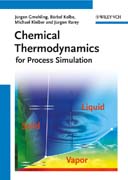
Chemical thermodynamics: for process simulation
Gmehling, Jurgen
Kolbe, Bärbel
Kleiber, Michael
This is the only book to apply thermodynamics to real-world process engineering problems, explaining the thermodynamics behind simulations to users of simulation programs. It comprises numerous solved examples, which simplify the understanding of the often complex calculation procedures, and discusses their advantages and disadvantages. The text also includes such special models as formaldehyde, polymers, and association. Estimation methods for thermophysical properties and phase equilibria, thermodynamics of alternative separation processes are covered, as are new developments from recent years. Recipes for the procedure are given at the end of each chapter, and further small programs are available via the Internet, such as mod. UNIFAC, MathCad and Excel files. While written for an advanced level, the text is easy to understand for every chemical engineer and chemist with a basic education in thermodynamics and phase equilibria, teaching students the engineering perspective of thermodynamics but also of interest to all companies active in chemistry, pharmacy, oil and gas processing, petrochemistry, refinery, food production, environmental protection and engineering. INDICE: Preface INTRODUCTION PVT BEHAVIOR OF PURE COMPOUNDS General Description Caloric Properties Ideal Gases Real Fluids Equations of State CORRELATION AND ESTIMATION OF PURE COMPONENT PROPERTIES Thermodynamic Properties Transport Properties PROPERTIES OF MIXTURES Property Changes of Mixing Partial Molar Properties Gibbs-Duhem Equation Ideal Mixture of Ideal Gases Ideal Mixture of Real Fluids Excess Properties Fugacity in Mixtures Activity and Activity Coefficients Application of Equations of State to Mixtures PHASE EQUILIBRIA IN FLUID PHASES Introduction Thermodynamic Fundamentals Application of Activity Coefficient Models Calculation of Vapor-Liquid Equilibria Using gE-Models Regression of gE-Model Parameters Henry Concept Calculation of Vapor-Liquid Equilibria Using Equations of State Conditions for Azeotropic Behavior Liquid-Liquid Equilibria Predictive Models CALORIC PROPERTIES Caloric Equations of State Enthalpy Description in Process Simulation Programs ELECTROLYTE SOLUTIONS Introduction Thermodynamics of Electrolyte Solutions Activity Coefficient Models for Electrolyte Solutions Dissociation Equilibria Solubility of Salts Influence of Salts on the Vapor-Liquid Equilibrium Behavior Complex Electrolyte Systems SOLID-LIQUID EQUILIBRIA Thermodynamic Relations for the Calculation of Solid-Liquid Equilibria Solid-Liquid Equilibria of Eutectic Systems Solid-Liquid Equilibriaof Solid Solutions Pressure Dependence of Solid-Liquid Equilibria Salt Solubilities OSMOSIS POLYMER THERMODYNAMICS Introduction Thermodynamic Polymer Models Phase Equilibria in Polymer Solutions APPLICATION OF THERMODYNAMICS IN SEPARATION TECHNOLOGY Application of Model Parameters Prior to Process Simulation Residual Curve Charts CHEMICAL REACTIONS Enthalpy of Reaction Pressure Dependence of Enthalpy of Reaction Chemical Equilibrium Simultaneous Chemical ReactionEquilibria SPECIAL MODELS Formaldehyde Solutions Vapor Phase Association PRACTICAL APPLICATIONS Flash Joule-Thomson Effect Compression. Expansion Isothermal Compression Pressure Relief Limitations of Equilibrium Thermodynamics LIST OF SYMBOLS APPENDIX Pure Component Parameters Coefficients for High-Precision Equations of State Useful Derivations Standard Potentials for Electrolyte Components Regression Technique for Pure Component Properties Regression Technique for Binary Parameters
- ISBN: 978-3-527-31277-1
- Editorial: Wiley-VCH
- Encuadernacion: Cartoné
- Páginas: 630
- Fecha Publicación: 23/11/2011
- Nº Volúmenes: 1
- Idioma: Inglés
